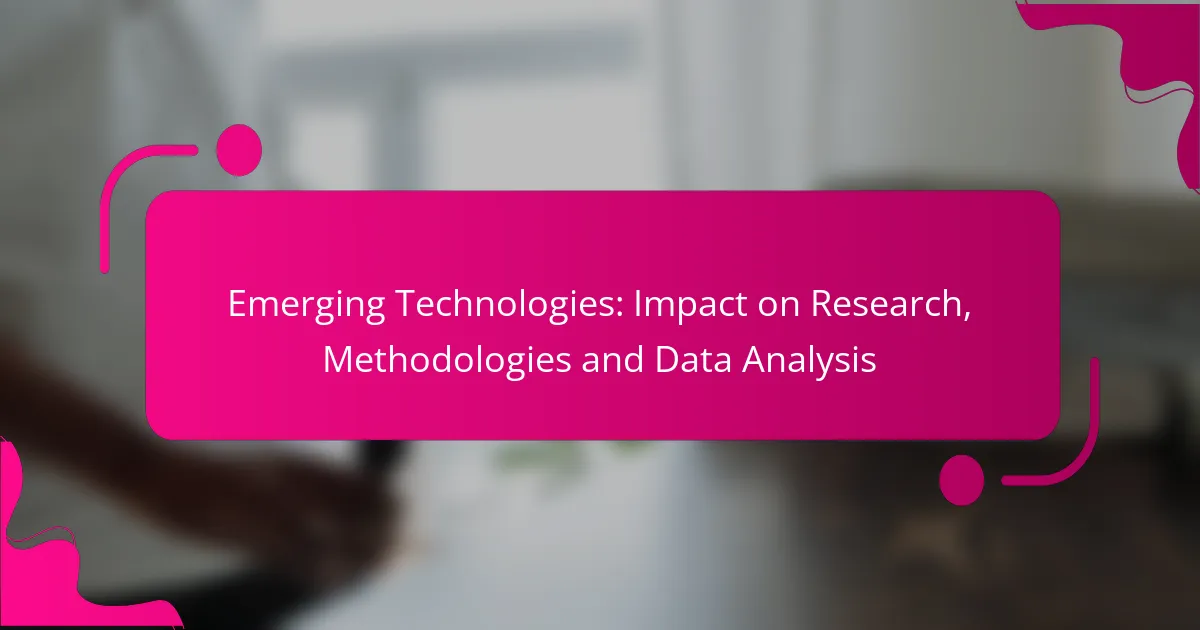Emerging technologies are revolutionizing research methodologies by introducing innovative tools that enhance both efficiency and accuracy. With advancements such as machine learning, blockchain, and natural language processing, researchers can improve data integrity and streamline analysis, leading to more reliable findings and collaborative opportunities across various disciplines.
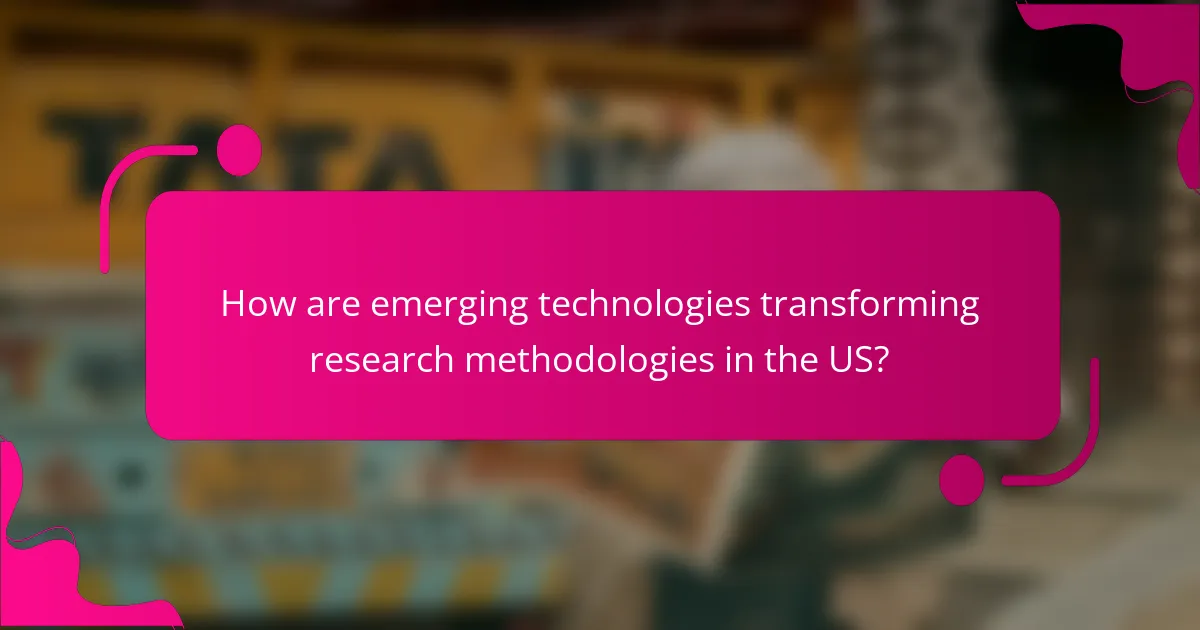
How are emerging technologies transforming research methodologies in the US?
Emerging technologies are significantly reshaping research methodologies in the US by introducing advanced tools and techniques that enhance efficiency and accuracy. These innovations streamline processes, improve data quality, and facilitate collaboration among researchers.
Increased automation in data collection
Automation in data collection reduces the manual effort required, allowing researchers to gather data more quickly and accurately. Tools like web scraping, automated surveys, and sensors can collect large volumes of data with minimal human intervention.
For example, researchers can use automated survey tools to distribute questionnaires and gather responses in real-time, significantly speeding up the data collection phase. This shift not only saves time but also minimizes human error in data entry.
Enhanced data visualization techniques
Emerging technologies provide advanced data visualization techniques that help researchers interpret complex datasets more effectively. Tools like interactive dashboards and 3D modeling allow for clearer representation of data trends and patterns.
Using software such as Tableau or Power BI, researchers can create dynamic visualizations that make it easier to communicate findings to stakeholders. This clarity can lead to better decision-making based on the insights derived from the data.
Integration of artificial intelligence in analysis
Artificial intelligence (AI) is increasingly integrated into data analysis, enabling researchers to uncover insights that may not be immediately apparent. AI algorithms can process vast amounts of data, identifying correlations and trends that human analysts might overlook.
For instance, machine learning models can predict outcomes based on historical data, providing valuable forecasts that inform future research directions. Researchers should consider the ethical implications of AI use, ensuring transparency and accountability in their methodologies.
Real-time data processing capabilities
Real-time data processing allows researchers to analyze data as it is collected, leading to immediate insights and quicker decision-making. Technologies such as stream processing frameworks enable the handling of continuous data flows from various sources.
This capability is particularly useful in fields like healthcare, where real-time monitoring of patient data can lead to timely interventions. Researchers must ensure they have the necessary infrastructure to support real-time analytics effectively.
Collaboration through cloud-based platforms
Cloud-based platforms facilitate collaboration among researchers by providing shared access to data and tools. These platforms enable teams to work together seamlessly, regardless of their physical location, enhancing productivity and innovation.
Tools like Google Drive and Microsoft Teams allow for easy sharing of documents and data, while also supporting real-time editing and communication. Researchers should leverage these platforms to foster collaboration and ensure that all team members are aligned on project goals and methodologies.
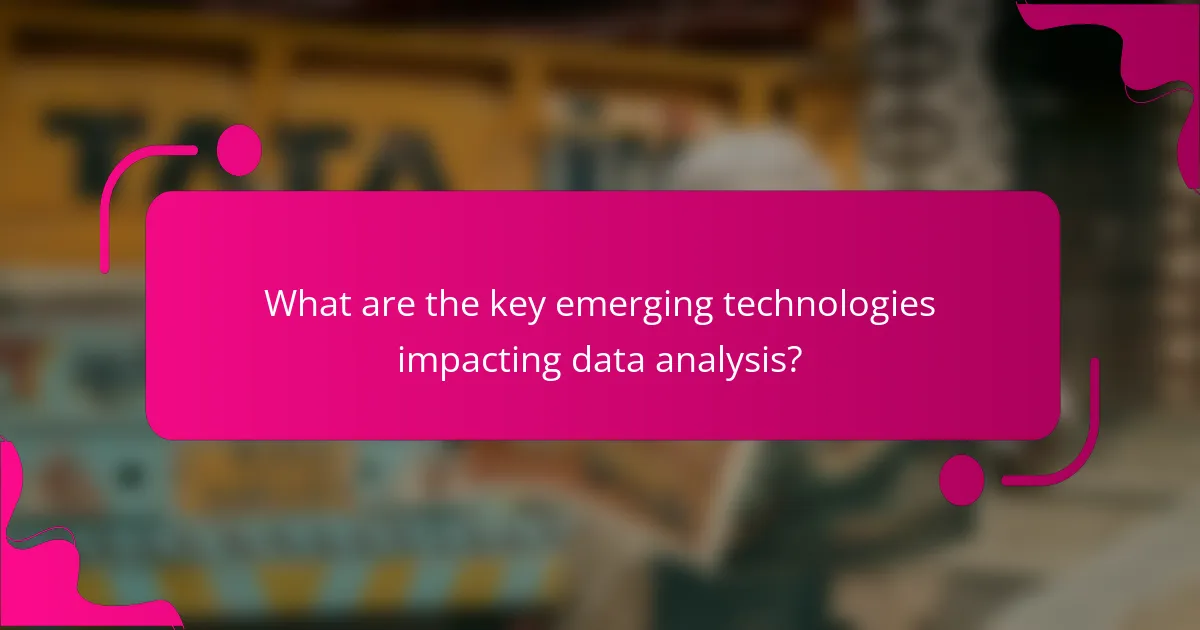
What are the key emerging technologies impacting data analysis?
Key emerging technologies such as machine learning, blockchain, natural language processing, and the Internet of Things are significantly transforming data analysis. These technologies enhance data integrity, improve analytical capabilities, and streamline data gathering processes.
Machine learning algorithms
Machine learning algorithms analyze large datasets to identify patterns and make predictions. They can automate data analysis tasks, allowing researchers to focus on interpreting results rather than manual calculations.
Common types of machine learning include supervised learning, unsupervised learning, and reinforcement learning. Each type has its own applications, such as classification, clustering, and decision-making, which can be tailored to specific research needs.
When implementing machine learning, ensure data quality and relevance. Poor data can lead to inaccurate models, so invest time in data cleaning and preprocessing before analysis.
Blockchain for data integrity
Blockchain technology provides a decentralized ledger that enhances data integrity by ensuring that records are immutable and transparent. This is particularly useful in fields like finance and healthcare, where data accuracy is critical.
Using blockchain, researchers can track data provenance, verifying the source and history of data points. This can help in maintaining compliance with regulations such as GDPR in Europe or HIPAA in the U.S.
Consider the trade-offs of implementing blockchain, such as the need for technical expertise and potential scalability issues. Weigh these against the benefits of enhanced security and trustworthiness in your data analysis.
Natural language processing tools
Natural language processing (NLP) tools enable the analysis of unstructured text data, extracting insights from sources like social media, surveys, and academic papers. NLP can automate sentiment analysis, topic modeling, and entity recognition.
Popular NLP frameworks include NLTK, SpaCy, and TensorFlow. These tools can help researchers process large volumes of text quickly, turning qualitative data into quantifiable insights.
When using NLP, be mindful of language nuances and context, as these can affect the accuracy of your analysis. Regularly update your models to adapt to evolving language use and trends.
Internet of Things (IoT) for data gathering
The Internet of Things (IoT) refers to interconnected devices that collect and exchange data. IoT sensors can gather real-time data from various environments, enhancing research capabilities in fields like environmental science and smart cities.
Examples of IoT applications include smart meters for energy consumption analysis and wearable devices for health monitoring. These devices can provide continuous data streams, allowing for more dynamic and responsive research methodologies.
When deploying IoT solutions, ensure robust data security measures are in place to protect sensitive information. Additionally, consider the costs associated with device maintenance and data management as part of your research budget.

How do these technologies affect research outcomes?
Emerging technologies significantly enhance research outcomes by improving data accuracy, speeding up project timelines, increasing data accessibility, and fostering collaboration among researchers. These advancements enable more reliable findings and efficient processes across various fields.
Improved accuracy in results
Emerging technologies, such as artificial intelligence and machine learning, enhance the accuracy of research results by analyzing vast datasets with precision. These tools can identify patterns and anomalies that human researchers might overlook, leading to more reliable conclusions.
For example, AI algorithms can process medical data to predict patient outcomes with a high degree of accuracy, which is crucial in fields like healthcare. Researchers should consider integrating these technologies to minimize errors and improve the validity of their findings.
Faster turnaround times for research projects
Technological advancements streamline research methodologies, allowing for quicker data collection and analysis. Automated data processing tools can reduce the time spent on repetitive tasks, enabling researchers to focus on interpretation and application.
In practice, projects that previously took months can often be completed in weeks. Researchers should leverage these tools to enhance efficiency and meet tight deadlines without compromising quality.
Greater accessibility to data
Emerging technologies facilitate greater access to data through cloud computing and open data initiatives. Researchers can now easily share and obtain datasets from various sources, breaking down traditional barriers to information access.
This accessibility allows for more comprehensive studies and encourages collaboration across disciplines. Researchers should actively seek out open data platforms to enrich their work and broaden their analytical perspectives.
Enhanced collaboration among researchers
Technologies such as collaborative software and online platforms foster enhanced collaboration among researchers, regardless of geographical location. These tools enable real-time communication and sharing of resources, making it easier to work together on complex projects.
For instance, platforms like GitHub allow researchers to collaborate on code and data analysis seamlessly. Embracing these technologies can lead to innovative solutions and a more integrated research community.
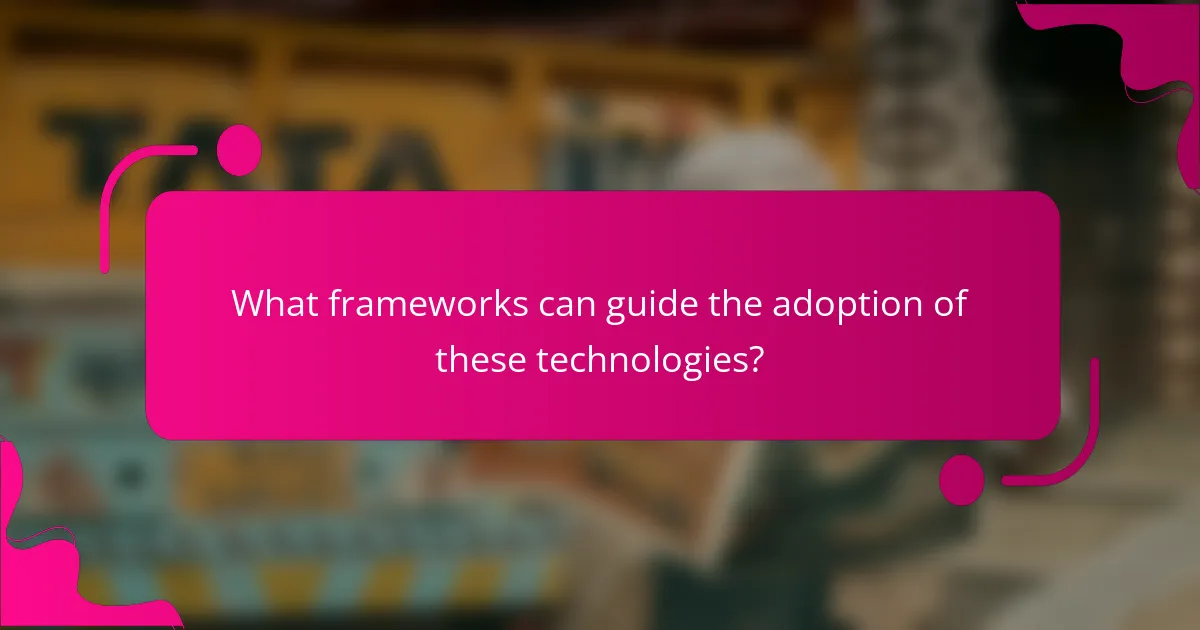
What frameworks can guide the adoption of these technologies?
Several frameworks can effectively guide the adoption of emerging technologies in research, methodologies, and data analysis. These frameworks help organizations assess readiness, evaluate costs versus benefits, and ensure that personnel are adequately trained to leverage new tools.
Technology readiness assessment
A technology readiness assessment (TRA) evaluates an organization’s preparedness to implement new technologies. This involves analyzing existing infrastructure, personnel capabilities, and the technology’s maturity level. A TRA typically includes a scoring system to gauge readiness across various dimensions, such as technical feasibility and organizational alignment.
For example, organizations can use a scale from 1 to 5, where 1 indicates minimal readiness and 5 signifies full preparedness. This assessment helps identify gaps and areas requiring improvement before full-scale implementation.
Cost-benefit analysis
Conducting a cost-benefit analysis (CBA) is crucial for understanding the financial implications of adopting new technologies. This analysis compares the expected costs, such as software licensing and training expenses, against the anticipated benefits, like increased efficiency or enhanced data accuracy. A well-structured CBA can reveal whether the investment is justified.
For instance, if the total costs are estimated at $50,000 while the projected benefits amount to $100,000 over a year, the CBA would indicate a favorable return on investment. Organizations should also consider indirect benefits, such as improved employee satisfaction and customer engagement.
Training and skill development programs
Implementing effective training and skill development programs is essential for maximizing the benefits of new technologies. These programs should be tailored to the specific needs of the organization and its employees, focusing on both technical skills and change management. Regular workshops and hands-on training sessions can facilitate smoother transitions.
Organizations should allocate a budget for training, which might range from a few thousand to tens of thousands of dollars, depending on the technology’s complexity and the number of employees involved. Additionally, fostering a culture of continuous learning can help employees adapt to ongoing technological changes.
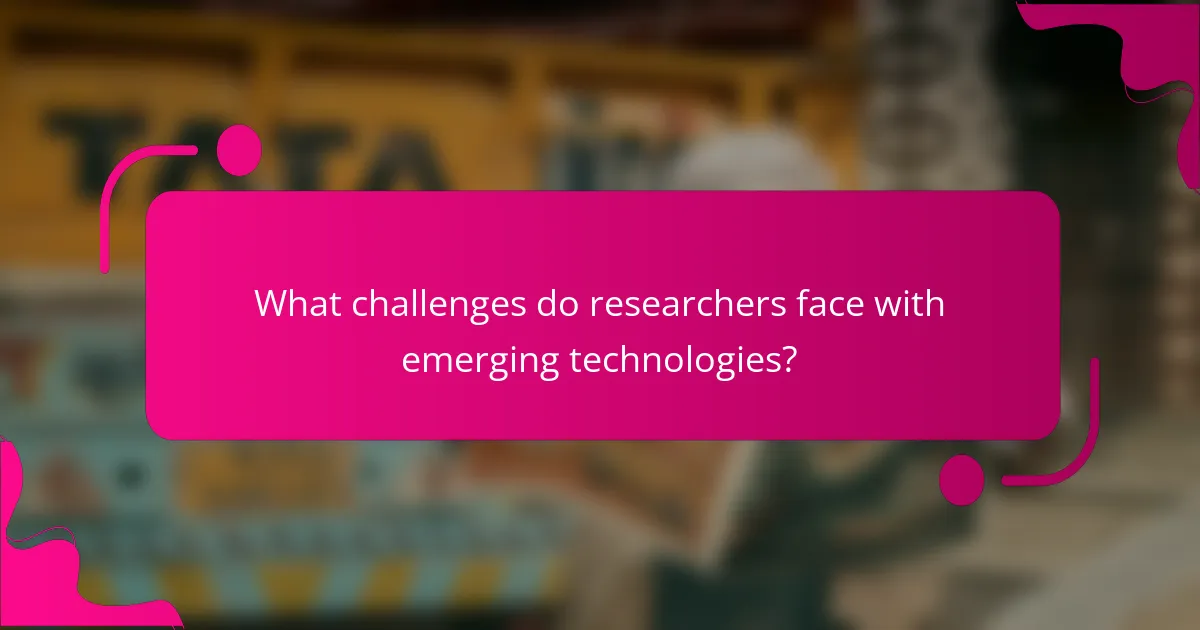
What challenges do researchers face with emerging technologies?
Researchers encounter several challenges when integrating emerging technologies into their work, including data privacy, security issues, and the need for updated methodologies. These challenges can hinder the effectiveness of research and the reliability of data analysis.
Data privacy and security concerns
Data privacy and security are significant challenges for researchers utilizing emerging technologies. The collection and analysis of large datasets often involve sensitive information, raising concerns about how this data is stored, accessed, and shared.
To mitigate these risks, researchers should implement robust data protection measures, such as encryption and anonymization. Familiarity with regulations like the General Data Protection Regulation (GDPR) in Europe can help ensure compliance and protect participant confidentiality.
Researchers should also conduct regular audits of their data handling practices and stay informed about the latest security threats. Establishing clear protocols for data access can further enhance security and trust among participants.
